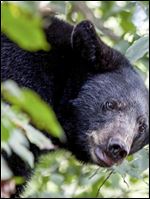http://www.toledoblade.com/MattMarkey/2015/04/07/Black-bears-continue-comeback.html#O1aCbc3yYUmYoU0t.
Black bears continue comeback
They became rare when Ohio forest was cleared for farming
Black bears once owned the forests of presettlement Ohio and Michigan, at a time when they were also present in all of what is now the 50 states, the Canadian provinces, and Mexico. As the human presence on the North American continent increased dramatically, bear numbers soon took a corresponding plunge.
Hunting and trapping of bears remained unregulated, and with significant amounts of Ohio forest being cleared for farming, bears were extirpated from Ohio sometime around the mid-1800s.
“They are a forest-dependent species, so that really knocked back the populations,” said Scott Peters, Wildlife Management Supervisor of the Ohio Division of Wildlife’s district office in northeast Ohio.
Around 30 years ago, bears started migrating into Ohio from the bordering states of West Virginia and Pennsylvania, which host large resident populations of this omnivorous and opportunistic feeder. Cubs remain with their mother until they are a year-and-a-half old, usually venturing out in June to locate and define their own territory.
“When you look at our neighboring states of West Virginia and Pennsylvania that, respectively, have 15,000 and 18,000 bears, they are going to become more common here in Ohio as time moves on,” Peters said.
Ohio had slightly fewer black bear sightings in 2014 compared to the previous year, but these sightings involved more individual animals, according to reports received by Ohio Department of Natural Resources biologists.
The Division of Wildlife documented 135 sightings that were believed to involve close to 90 individual black bears in 2014, while 158 sightings were on record from 2013, but those were connected to an estimated 74 black bears. Sightings are classified as confirmed if they can be linked to evidence, such as tracks, photos, or trail camera images.
Since black bears are shy and reclusive and tend to prefer large, heavily forested areas, sightings are not a precise measure of their presence in a given range. That could explain the inconsistent sighting numbers in Ohio — 135 in 2014, 158 in 2013, 224 in 2012, and 152 in 2011. Individual bears likely account for multiple sightings throughout the year.
The geographical trend connected to the black bear sightings continued as expected, with the bulk of the confirmed cases occurring in counties in the northeast and southeast parts of Ohio, adjacent to the black bear habitat of West Virginia and Pennsylvania.
In 2014, more than half of the confirmed sightings took place in May and June. Sightings were reported in 43 of Ohio’s 88 counties, with Hamilton County reporting its first verified sighting. The most sightings occurred in Ashtabula and Trumbull counties, with each reporting 21 cases.
Ohio had two confirmed reports of sows with cubs last year, both coming from Athens County. In one of the cases, the young bear appeared to be a yearling.
Black bears in Ohio and Michigan eat primarily herbaceous matter such as nuts, fruits, and berries, but they will also graze on crops such as corn and wheat. Michigan’s estimated 19,000 black bears are concentrated in the Upper Peninsula and the northern section of the Lower Peninsula, but the population is moving south as bears adapt to more fragmented habitat with some forest and wooded riparian zones.
Michigan has a limited bear hunting season, while black bears are classified as endangered in Ohio and no bear hunting is allowed.
Bears are creative and take advantage of convenient food sources. Most of the 25-30 reports of nuisance bears that the Ohio Division of Wildlife deals with each year involve bears raiding bird feeders, trash cans, or outdoor grills.
“One of the best ways to deal with nuisance bears is very similar to dealing with potentially nuisance animals such as raccoons and skunks, and that is simply removing any outside food attractants,” Peters said. “When a bear is in an area, if you can remove any food source, that will definitely help to deter a nuisance situation in the future.”
In unusual or extreme cases, nuisance bears are sometimes trapped and relocated to more remote areas. Peters said the Division of Wildlife is encouraging the comeback of black bears, one of Ohio’s native species.
“They are a very important part of our forest ecosystem component here in Ohio,” he said. “Our job is to find a balance between this animal returning to the natural ecosystem, and balancing that with the sociological aspect of tolerating people, agricultural damage, and bear-vehicle accidents.”
Read more at http://www.toledoblade.com/MattMarkey/2015/04/07/Black-bears-continue-comeback.html#DygQ72gYqKi4V6xu.99











No comments:
Post a Comment